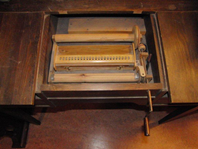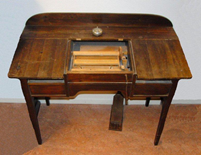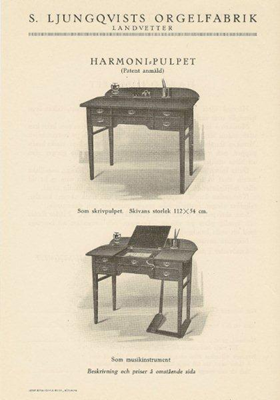‘Harmoni-pulpet’ (automatic harmonium contained in a desk), S. Ljungqvist, c. 1923, KH 423
Sanfrid Ljungqvist (1872-1950) was a farmer’s son from Saleby in Västergötland and worked his way up to become an organ builder via the local elementary school teacher, carpentry training in Lidköping (1888), a borrowed organ that he copied, and and finally from 1897 employment at Lindgren’s Orgelfabrik in Stockholm.
In 1899 he was ready to open his own business in Vänersborg. The factory remained there until 1915, when it was moved to Landvetter outside Gothenburg. Ljungqvist only made harmoniums, and never succumbed to the temptation to include pianos and grand pianos in his production. During financially difficult times with poor orders for the organs, however, he made “special furniture”.
Around 1920, Ljungqvist was busy with inventions to technically improve the manufacture of organs. In addition, he intended to build “en mekanisk orgel, som alla kunde spela på utan att ha lärt sig något och utan att vara musikaliska” (a mechanical organ, which anyone could play without having learned anything and without being musical). It became a combined organ and desk, which he called the Harmonipulpet (HP). Under the flap on the desk is an organette (a self-playing harmonium without a keyboard). Two rollers feed a “punched roll” of paper with punched holes. Turning the cylinder passes the punch roll over the reeds (brass), which sound as air passes through them. In order to make these, Ljungqvist manufactured a special punching machine.
The “Harmoni-pulpet” was shown at the Jubilee exhibition in Gothenburg in 1923 but was not a sales success, which is why the production was discontinued quite soon. The era of self-playing instruments was over around 1920, and was instead replaced by the radio and the gramophone, which had an impact during the “swinging 20s”. Our “HP”, which was never completed (the flap is missing), belonged to the Ljungqvist family and was acquired for Klaverens Hus as a “bonus” when buying one of Ljungqvist’s parlor organs. The instrument came with a box of music rolls.



References:
- “Till hundraårsminnet av fars födelse” [Remembering 100 years since our father’s birth], Family book written by Ljungqvist’s daughter Kerstin and dedicated to “dem som ännu bryr sig om gamla klaverinstrument och deras historia” [those who still care about old keyboard instruments and their history].
- Company salesbook, 1915-ca. 1940
